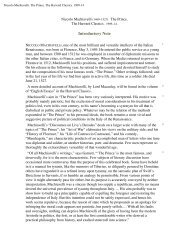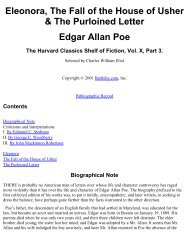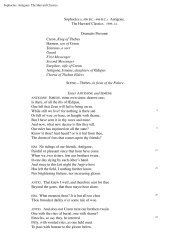Notre Dame de Paris - Bartleby.com
Notre Dame de Paris - Bartleby.com
Notre Dame de Paris - Bartleby.com
Create successful ePaper yourself
Turn your PDF publications into a flip-book with our unique Google optimized e-Paper software.
architecture, sister of the theocratic buildings of Egypt and India, inalterable emblem of pure<br />
Catholicism, immutable hieroglyph of papal unity. The whole ten<strong>de</strong>ncy of the time is written in this<br />
sombre Romanesque style. Everywhere it represents authority, unity, the imperturbable, the absolute,<br />
Gregory VII; always the priest, never the man: everywhere the caste, never the people.<br />
Then <strong>com</strong>e the Crusa<strong>de</strong>s, a great popular movement, and every popular movement, whatever its cause<br />
or its aim, has as its final precipitation the spirit of liberty. Innovations struggled forth to the light. At this<br />
point begins the stormy period of the Peasant wars, the revolts of the Burghers, the Leagues of the<br />
Princes. Authority totters, unity is split and branches off into two directions. Feudalism <strong>de</strong>mands to<br />
divi<strong>de</strong> the power with theocracy before the inevitable advent of the people, who, as ever, will take the<br />
lion’s share—Quia nominor leo. Hence we see feudalism thrusting up through theocracy, and the<br />
people’s power again through feudalism. The whole face of Europe is altered. Very good; the face of<br />
architecture alters with it. Like civilization, she has turned a page, and the new spirit of the times finds<br />
her prepared to write to his dictation. She has brought home with her from the crusa<strong>de</strong>s the pointed arch,<br />
as the nations have brought free thought. Henceforward, as Rome is gradually dismembered, so the<br />
Romanesque architecture dies out. The hieroglyphic <strong>de</strong>serts the Cathedral, and goes to assist heraldry in<br />
heightening the prestige of feudalism. The Cathedral itself, once so imbued with dogma, inva<strong>de</strong>d now by<br />
the <strong>com</strong>monalty, by the spirit of freedom, escapes from the priest, and falls un<strong>de</strong>r the dominion of the<br />
artist. The artist fashions it after his own good pleasure. Farewell to mystery, to myth, to rule. Here<br />
fantasy and caprice are a law unto themselves. Provi<strong>de</strong>d the priest has his basilica and his altar, he has<br />
nothing further to say in the matter. The four walls belong to the artist. The stone book belongs no more<br />
to the priest, to religion, to Rome, but to imagination, to poetry, to the people. From thenceforward occur<br />
these rapid and innumerable transformations of an architecture only lasting three centuries, so striking<br />
after the six or seven centuries of stagnant immobility of the Romanesque style. Meanwhile, Art marches<br />
on with giant stri<strong>de</strong>s, and popular originality plays what was formerly the Bishop’s part. Each generation<br />
in passing inscribes its line in the book; it rubs out the ancient Roman hieroglyphics from the<br />
frontispiece—hardly that one sees here and there some dogma glimmering faintly through the new<br />
symbol overlying it. The framework of religion is scarcely perceptible through this new drapery. One can<br />
scarcely grasp the extent of the license practised at that time by the architects, even on the churches. Such<br />
are the shamelessly intertwined groups of monks and nuns on the capitals of the Gallery of<br />
Chimney-Pieces in the Palais <strong>de</strong> Justice; the episo<strong>de</strong> out of the history of Noah sculptured “to the letter”<br />
over the Cathedral door at Bourges; the bacchic monk, with ass’s ears and glass in hand, grinning in the<br />
face of a whole congregation, carved on a stone basin of the Abbey of Bocherville. For the thought<br />
written in stone there existed at that period a privilege perfectly <strong>com</strong>parable to the present liberty of the<br />
press. It was the liberty of architecture.<br />
And the liberty went far. At times a door, a faça<strong>de</strong>, nay, even an entire church, presents a symbolical<br />
meaning wholly unconnected with worship, even inimical to the Church itself. In the thirteenth century,<br />
Guillaume of <strong>Paris</strong>, and in the fifteenth, Nicolas Flamel wrote such seditious pages.<br />
Saint-Jacques-<strong>de</strong>-la-Boucherie was a <strong>com</strong>plete volume of opposition.<br />
This was the only form, however, in which free thought was possible, and therefore found full<br />
expression only in those books called edifices. Un<strong>de</strong>r that form it might have looked on at its own<br />
burning at the hands of the <strong>com</strong>mon hangman had it been so impru<strong>de</strong>nt as to venture into manuscript: the<br />
thought embodied in the church door would have assisted at the <strong>de</strong>ath agony of the thought expressed in<br />
the book. Therefore, having but this one outlet, it rushed towards it from all parts; and hence the<br />
countless mass of Cathedrals spread over all Europe, a number so prodigious that it seems incredible,










